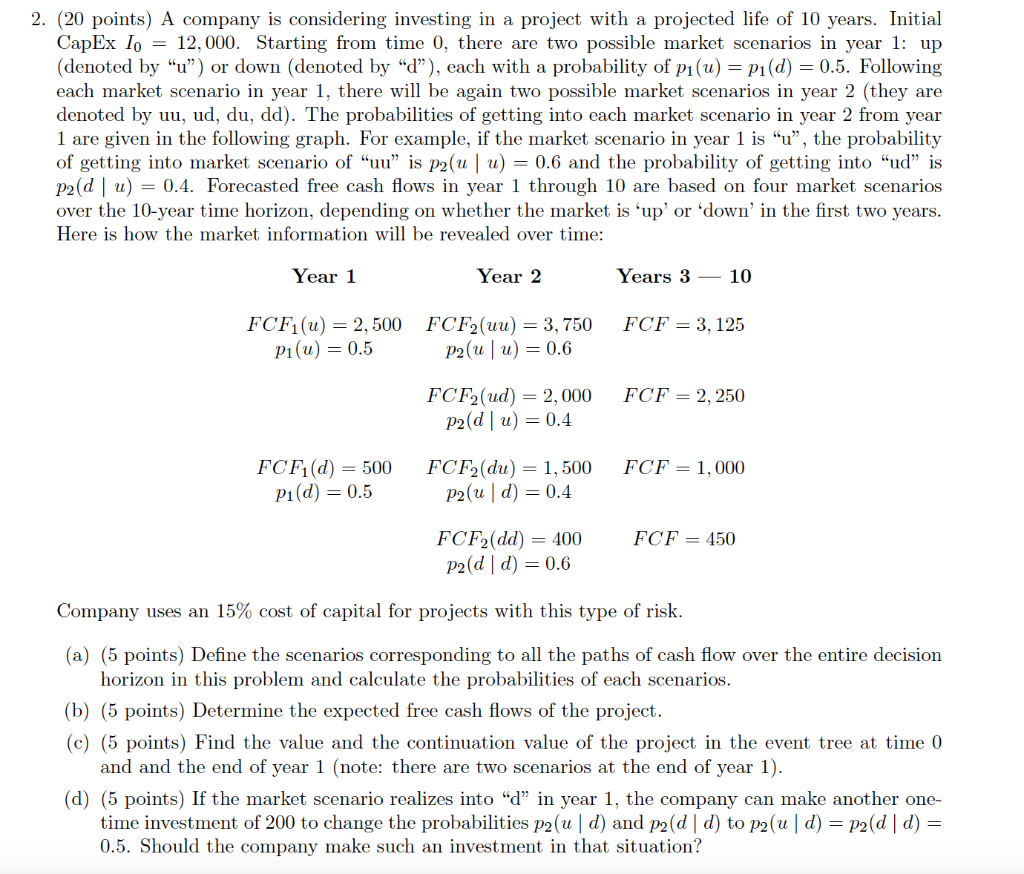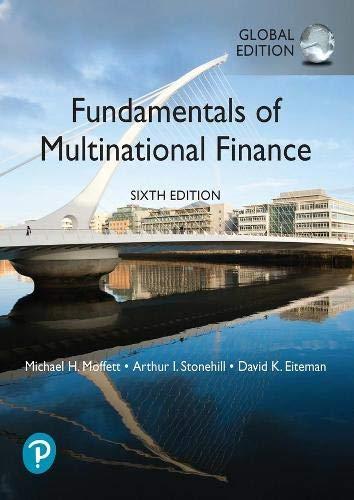
2. (20 points) A company is considering investing in a project with a projected life of 10 years. Initial CapEx Io = 12,000. Starting from time 0, there are two possible market scenarios in year 1: up (denoted by "u") or down (denoted by d), each with a probability of p(u) = P1(d) = 0.5. Following each market scenario in year 1, there will be again two possible market scenarios in year 2 (they are denoted by uu, ud, du, dd). The probabilities of getting into each market scenario in year 2 from year 1 are given in the following graph. For example, if the market scenario in year 1 is "u", the probability of getting into market scenario of uu is p2(u | u) = 0.6 and the probability of getting into ud is P2d | u) = 0.4. Forecasted free cash flows in year 1 through 10 are based on four market scenarios over the 10-year time horizon, depending on whether the market is 'up' or 'down' in the first two years. Here is how the market information will be revealed over time: Year 1 Year 2 Years 3 10 FCF = 3, 125 FCFi(u) = 2,500 pi(u) = 0.5 FCF2(uu) = 3,750 P2(uu) = 0.6 FCF = 2, 250 FCF2(ud) = 2,000 P2(d | u) = 0.4 FCF = 1,000 FCFi(d) = 500 P1(d) = 0.5 FCF2(du) = 1,500 P2(ud) = 0.4 FCF = 450 FCF2(dd) = 400 P2( dd) = 0.6 Company uses an 15% cost of capital for projects with this type of risk. (a) (5 points) Define the scenarios corresponding to all the paths of cash flow over the entire decision horizon in this problem and calculate the probabilities of each scenarios. (b) (5 points) Determine the expected free cash flows of the project. (c) (5 points) Find the value and the continuation value of the project in the event tree at time 0 and and the end of year 1 (note: there are two scenarios at the end of year 1). (d) (5 points) If the market scenario realizes into d in year 1, the company can make another one- time investment of 200 to change the probabilities p2(u | d) and p2(dd) to p2(u | d) = P2d|d) = 0.5. Should the company make such an investment in that situation? 2. (20 points) A company is considering investing in a project with a projected life of 10 years. Initial CapEx Io = 12,000. Starting from time 0, there are two possible market scenarios in year 1: up (denoted by "u") or down (denoted by d), each with a probability of p(u) = P1(d) = 0.5. Following each market scenario in year 1, there will be again two possible market scenarios in year 2 (they are denoted by uu, ud, du, dd). The probabilities of getting into each market scenario in year 2 from year 1 are given in the following graph. For example, if the market scenario in year 1 is "u", the probability of getting into market scenario of uu is p2(u | u) = 0.6 and the probability of getting into ud is P2d | u) = 0.4. Forecasted free cash flows in year 1 through 10 are based on four market scenarios over the 10-year time horizon, depending on whether the market is 'up' or 'down' in the first two years. Here is how the market information will be revealed over time: Year 1 Year 2 Years 3 10 FCF = 3, 125 FCFi(u) = 2,500 pi(u) = 0.5 FCF2(uu) = 3,750 P2(uu) = 0.6 FCF = 2, 250 FCF2(ud) = 2,000 P2(d | u) = 0.4 FCF = 1,000 FCFi(d) = 500 P1(d) = 0.5 FCF2(du) = 1,500 P2(ud) = 0.4 FCF = 450 FCF2(dd) = 400 P2( dd) = 0.6 Company uses an 15% cost of capital for projects with this type of risk. (a) (5 points) Define the scenarios corresponding to all the paths of cash flow over the entire decision horizon in this problem and calculate the probabilities of each scenarios. (b) (5 points) Determine the expected free cash flows of the project. (c) (5 points) Find the value and the continuation value of the project in the event tree at time 0 and and the end of year 1 (note: there are two scenarios at the end of year 1). (d) (5 points) If the market scenario realizes into d in year 1, the company can make another one- time investment of 200 to change the probabilities p2(u | d) and p2(dd) to p2(u | d) = P2d|d) = 0.5. Should the company make such an investment in that situation







